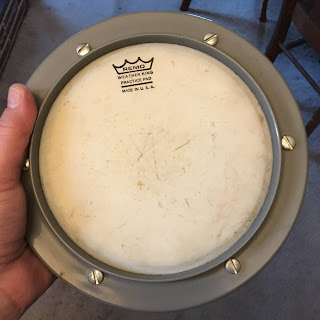
I went to the music teacher and asked about my options for learning an instrument.
After I explained that my parents could not afford to rent an instrument from the music store, and that whatever I chose would have to be on loan from the school district, the band director told me there weren’t many loaner instruments available.
It also had to be something I could get to and from school on my bicycle, because this was the era of latchkey kids and learning self-sufficiency. Ultimately, the only remaining choice that appealed to me was to learn to play the drum. A practice pad and sticks cost less than ten dollars, fit easily in my backpack and was quiet enough to practice anywhere. Plus, Karen Carpenter was a drummer long before she ever began singing, and she was one of my childhood idols. So that decided it.
I was presented with a copy of the Belwin Band Builder, a pair of 5A Ludwig drum sticks and a Remo tunable practice pad. With a 6-inch diameter plastic head, it looked like the top of a drum, and when you played it, it sort of sounded like a little drum; plus, the head was tunable and if you broke it you could buy replacements — the sort of thing that was sure to please my economy-minded mother.
I wore that first pad out by the time I got to high school, going through two replacement heads before I had cracked the plastic rim. I saved up my babysitting and paper route money and bought another, larger Remo pad in an 8-inch diameter size, which got me through high school. By then, I had gravitated to other styles of practice pad (including scrap rubber duct-taped to a wooden plank), and it was a long time before I bought another Remo tunable pad.
Fast forward to 2005. I was inspired to audition for a community wind ensemble, and needed to fill in my meager supply of drum sticks, mallets and other ephemera. I also needed a practice pad, so I went looking for something cheap — and found a “vintage” 6-inch Remo tunable pad in its original box, with the paperwork. It was being sold as a “collectible” and cost me almost twenty bucks. As it happened, that vintage drum pad purchase became the foundation of the practice pad collection I have today. I wound up hardly using it for regular practice because I had found other, more modern pads that I preferred. So it has mostly sat on a shelf in its little cardboard box.
The Remo tunable practice pad remains a stalwart, the pad you start a beginner with because it’s durable, still quite affordable — and easy to find used at garage sales for even less than I’d paid for my very first pad. The pad is still in production today and remains a best-seller, ideal for student drummers on a budget and anyone else looking for something that just works; though the current version is mostly plastic throughout and has no metal platform to provide a slight tilt, as my old pads had. There's even a version called Silent Stroke, with a mesh head for much quieter practice.
Here’s a few photos of the pad I bought used some fifteen years ago, and the paperwork that came with it. My pad dates from the mid to late 1970s, and utilizes both a “tilt” platform and a threaded hole for mounting on a cymbal stand.

A little instruction booklet that came with the pad



(Click on each page to get a larger photo)
A letter from Remo Belli and a quality pledge. Did these things once matter to customers?

When my interest in collecting pads and researching their history expanded, I found photos of an older version of this pad, made with a metal rim.
My next quest would be to find an older version of the Remo tunable pad so I could make comparisons. Stay tuned for Part II of this exploration into a really cool corner of practice pad history, and happy drumming.



No comments:
Post a Comment